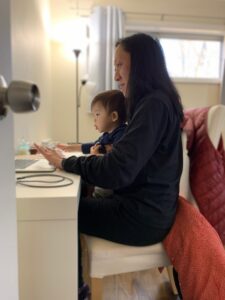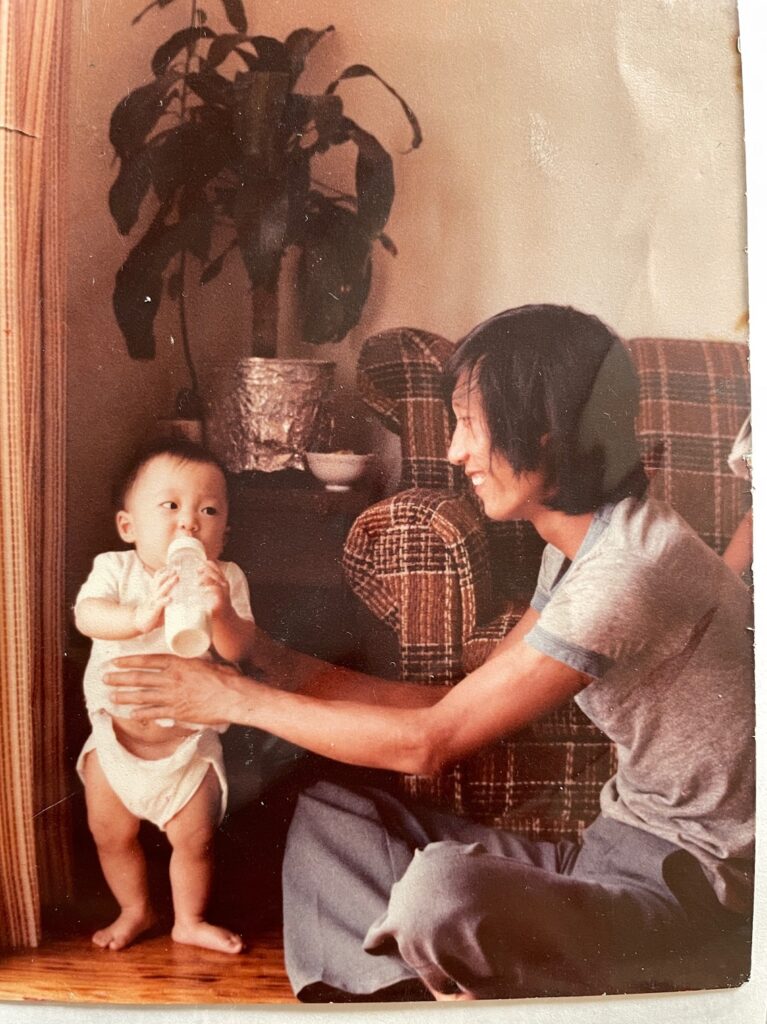March 21, 2022 IN: Our Voices, Staff Blog
Creating a Culture of Community Care

by Quyên Đinh

Quyên and her son, Khải, attending a Zoom meeting. (Photo courtesy of Quyên Đinh)
In February of 2021, I returned to SEARAC from a once-in-a-lifetime opportunity of becoming a mom. This was possible through six months of paid leave with a two-month sabbatical and four months maternity leave. The first two days back were rough, especially with my 4-month-old waking every two to three hours during the night. Just getting through eight hours of work was exhausting. But after I got my footing, I realized that my battery was not just recharged but upgraded.
This blessing would not have happened had it not been for SEARAC’s amazing staff who were part of my coverage team.
On my first Zoom staff meeting back in the office, I was super-excited to see my team again and to thank them for their leadership. What greeted me was shocking. The lifeless faces looking back at me told me that the team was beyond exhausted. In my check-ins with other leaders, I heard the same story: that the field was hurt and burnt-out, that the rapid response of COVID had taken a toll on its community caretakers, that we were in crisis.
I knew that to protect this team, and the organization, I needed to do something big, and I needed to do it soon.
Our answer became the four-day work week.
I returned in February, and by May we launched the four-day work week. The policy has changed each and every one of our lives. Here are the three biggest decisions we made to get to where we are today:
Saying no: right-sizing our priorities to allow for nimbleness and impact.
When I first returned from leave, I could not get through our organization’s annual work plan without heart palpitations. I was overwhelmed just reading the document. The scope was too big. While we had gotten really good during the start of the pandemic at assessing and reassessing our priorities, by 2021 we had defaulted to taking on work beyond our capacity for good reason: our community’s demands and needs always outweigh our capacity, and the needs had grown exponentially. But the faces on that Zoom told me that we as an organization wouldn’t exist and endure through the long haul that’s needed for this work if we kept going at our current pace.
I knew that to protect this team, and the organization, I needed to do something big, and I needed to do it soon.
I went to our management team and asked them to take a step back. We removed “nice-to-have” items from our workplans and moved more items to our “not do” list. By laser-focusing our work on what we do really well — and letting go of items we didn’t have to do — we made room to add on the unexpected work/crises/opportunities that are inevitable in this field. And by letting go, we were structurally ready for the unplanned. Instead of constantly being in reaction mode, we had the time to make responsive decisions.
I learned that sometimes the most powerful decision a leader can make is saying no, and taking on all the potential short-term consequences for the sake of long-term sustainability. This was a challenge we have always faced as an organization, but the pandemic gave us the opportunity to rethink and rewire our work for the long-game.
We all take Fridays off, including me.
When I created my action plan to shift us, our colleagues at The Women’s Foundation California were integral in being my thought partner as they shared their lessons learned from making the official switch. One of my biggest lessons from them was that everyone had to take the same day off. During the pandemic, they had experimented with reduced hours (just as we did), but everyone had a different day off/different reduced hours. Those who were working would then create work for those who were off. Those who were off came back to an overflowing plate of work before they could even sit down. This was exactly what we had experienced at SEARAC. By taking the same day off as an organization, we were able to sustain a manageable pace and workflow for everyone.
As executive director (ED), I am the top leader everyone is looking to for modeling. And yes, I too take Fridays off. At the beginning of the pandemic in 2020 when we reduced our hours to 32-35 hours, I was working 50, as were all of my other ED colleagues. But that changed when we officially switched to our four-day work week and everyone took Fridays off. It took me about a month to balance my workload, but today, working on a Friday is the exception and not the rule. When I do work on Fridays, I adjust hours the next week to account for those hours worked. And I schedule emails to be sent at noon on Monday so that my team won’t be bombarded with new work once they’ve returned from their weekends.
With a four-day work week, my brain doesn’t stop thinking about work. But by Monday, I’m ready to put the ideas and questions I’ve ruminated on through the weekend into action. I don’t need to spend Monday settling into the week. The rest and restoration I’ve been able to achieve through that extra day makes me even more efficient and productive through the week.
We chose to dream, and to make those dreams a reality.
When the pandemic hit in 2020, I ate up every single article I could find on adjusting to this never-before-seen catastrophe. One of the blogs I read encouraged teams to think about this question: “What unimaginable solution could you think of?” When posed to the SEARAC staff, one of our team members joked, “A four-day work week.”
To me that wasn’t a joke, but a dream that we could make possible.
We learned a lot as we struggled to get to where we are today, and today our four-day work week is institutionalized in practice and policy.
Today, this policy allows me to live a life my parents never dreamed possible.

Quyên as a baby with her dad. (Photo courtesy of Quyên Đinh)
Coupled with our work-from-home policy, I get to be part of my son’s life from the time he wakes to the time he goes to sleep. I get to play with him until I work, spend my breaks and lunch with him and my husband, hug and sing to him to put him down for his nap, and enjoy dinner and playtime before I put him down for bed.
When I was an infant, my Dad would often spend months at sea as a fisher on a shrimp boat in New Orleans. He passed away last August, and during his final days, we looked at a picture of us taken after one of those trips, and he said, “We were so poor back then. That was the only way I could bring in money.” Growing up, he worked multiple jobs to make ends meet. He didn’t choose work over family. He chose work because of family. In his final weeks and days, he saved every single minute of time and his remaining breaths for his children and grandchildren. When he passed, I realized that nothing in life matters but family.
As ED, I have the privilege, power, and responsibility to turn my family values into organizational policies that protect all of our families in all of its chosen forms. Our policies are not about self-care that put the onus of care on the individual. Our policies put the onus on community care: on making organizational decisions that allow for everyone to be able to take care of each other and themselves. As an organization whose top mission is to care for its community, and to champion policies for the community’s right to heal, we apply those same values to the team members who work everyday to make that mission—a dream of an equitable future—a reality.
Equity takes generations to achieve. SEARAC hopes that our modeling contributes to a larger shift in the social justice movement and America to redefine what health, wellness, and wholeness can look like for generations to come.
We are building a new normal to build resilience, so that future generations can inherit a healthy organization and community as they extend and grow our dreams beyond our wildest imaginations.
Quyên Đinh is SEARAC’s Executive Director. You can email her here.
For more blogs in our #WorkplaceWellness series, see:
- Elaine Sanchez Wilson: Work/Life, Reimagined
- Huong Nguyen-Yap: Putting Care Into Practice
- Danny Doan: Breaking Away From the Work Hustle
- Phun H: Strength in Rest
- Jenna McDavid: Blooming, growing, and healing – at work and at home
- Katrina Dizon Mariategue: Taking a Pause





